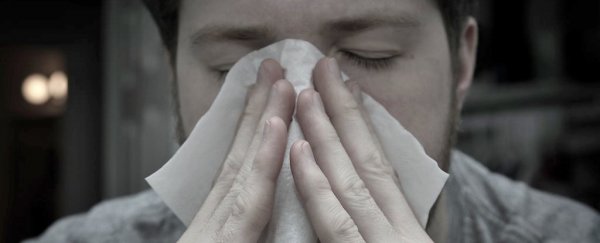For centuries now, humans have been chasing a cure for the common cold, but it's seemed so entirely out of our grasp, it's become modern medicine's version of pigs flying.
But maybe we don't need a cure after all, because an Austrian scientist has just registered a patent for a common cold vaccine, and says it could be on the market in less than a decade.
Before we get ahead of ourselves here, let's be clear that a patent application in no way guarantees that Rudolf Valenta, an allergy expert at the Medical University of Vienna, has the most viable candidate out there for a common cold vaccine.
But what it does suggest is that Valenta, who's been investigating preventative measures for cold and allergy symptoms for decades, thinks he's onto something big, and is confident that he now knows how to block the notorious human rhinovirus for good.
As he explained to Katie Forster at The Independent, the actual technology isn't all that revolutionary - in fact, it's based on a long-established principle of getting the body's own immune system to readjust its response to the virus.
The key is making the immune system change how it attacks a rhinovirus infection - the predominant cause of the common cold.
Instead of the immune system trying - and failing - to break into the centre of the virus as usual, the vaccine directs the immune response towards the virus's outer shell.
Valenta says this addresses the biggest challenge when it comes to curing or preventing the spread of the common cold - the incredible variety of the 99 known strains of human rhinovirus, and the disease's ability to mutate away from our immune response.
"We've taken pieces of the rhinovirus shell, the right pieces, and attached it to a carrier protein. It's a very old principle, to refocus the antibody response," he told Forster.
"The diversity [of rhinovirus strains] is less of an issue than getting the right spot on the virus."
The patent application was submitted to the European Patent Register, and points to more than 200 scientific papers as a basis for the technology.
Following Valenta as the lead inventor of the vaccine are 12 more researchers from Austria who have assisted in its development.
The vaccine is based in part on research conducted at the Vienna General Hospital in 2012, where Valenta and his colleagues examined 59 young patients and their response to the rhinovirus.
One of the key findings of this study was that the body's immune system tries to neutralise the virus by attaching antibodies - large proteins that help to identify and attack harmful viruses and bacteria - to a part of the virus that becomes exposed once its outer shell is peeled away.
When antibodies attach themselves to a virus, the areas they bind to are called epitopes, and the researchers found that the particular epitope that the antibodies insisted on binding to in the human rhinovirus was a 'non-neutralising' - or ineffective - one.
Add the immune system's habit of attaching itself to a useless area of the virus to the fact that the virus can rapidly mutate in response to all of this, and you've got a recipe for failure if you leave the body to deal with the common cold on its own.
"In addition to strain variability, which may prevent protection against rhinovirus infections, we propose misdirection of antibody responses against rhinovirus as a potential novel mechanism of how rhinovirus may escape protective immunity in humans," Valenta and his team wrote in The FASEB Journal.
"Based on our results, it should be possible to engineer vaccines that allow the redirecting of antibody responses against neutralising rhinovirus epitopes and to treat rhinovirus-related diseases, such as common cold and exacerbations of asthma and chronic obstructive pulmonary disease (COPD)."
We'll have to wait and see if anything comes of this patent application and the technology it protects, but Valenta is sounding pretty hopeful at this stage.
"With the first protein we built, we have very good inhibition [of the disease] already. We believe that we are on a really good track with what we're doing," he told The Independent.
"If we get also the trial funded properly, it could be done between six to eight years. We know how to build the vaccines and get it to the clinic. This is really in reach."
Jonathan Ball, a professor of molecular virology at the University of Nottingham in the UK, who was not involved in the research, says the team "might be onto something", but considering the challenges ahead, it's too soon to get excited just yet.
Watch this space.
